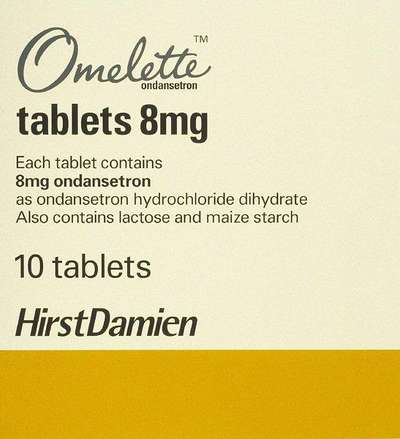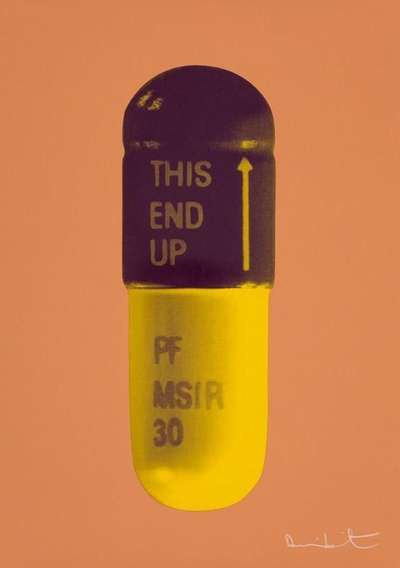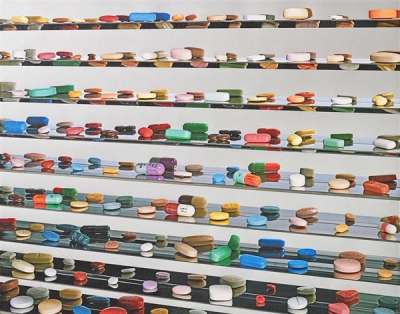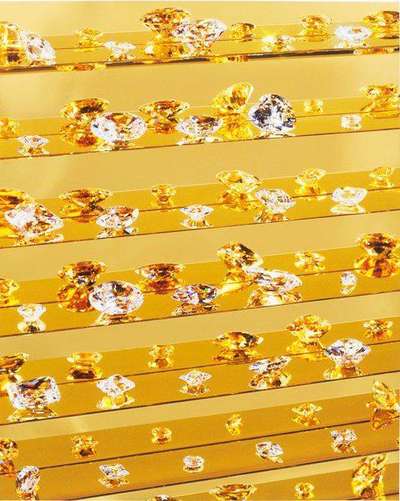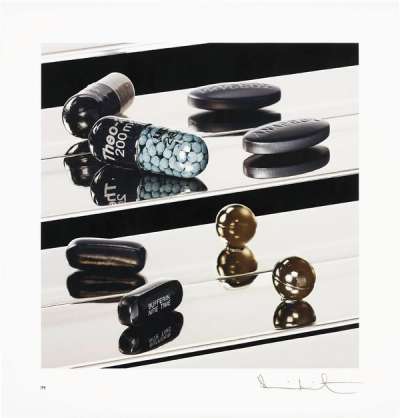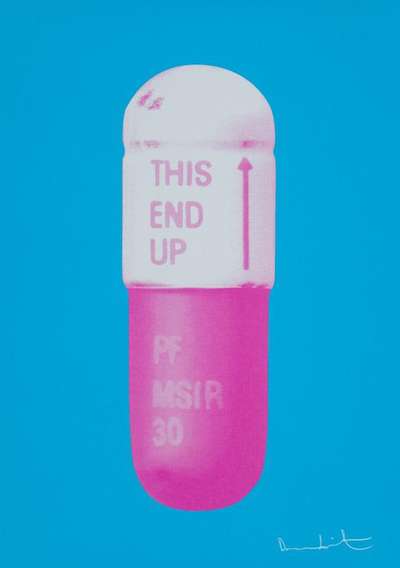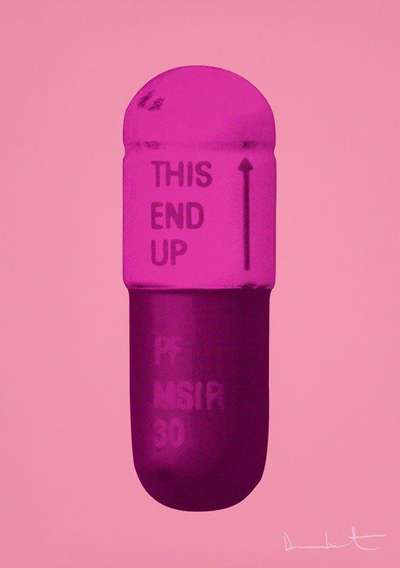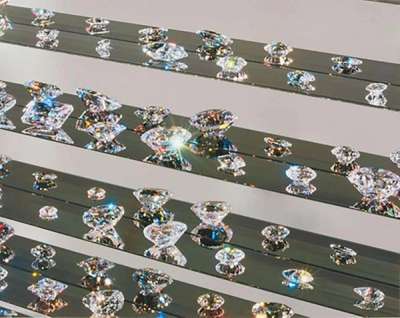The Pharmacist Artist: Damien Hirst's Representation of Pills

 Omelette © Damien Hirst 1999
Omelette © Damien Hirst 1999
Damien Hirst
655 works
Damien Hirst, one of the most audacious and controversial figures in contemporary art, has been captivated by the enigmatic world of pharmaceuticals. Early on, Hirst has consistently challenged the boundaries of conventional art, using materials and themes that compel viewers to confront their beliefs, fears, and vulnerabilities. At first glance, these works might appear as a critique of the commercial and sometimes impersonal nature of the pharmaceutical industry. However, deeper insights reveal Hirst's nuanced exploration into how medicine, a symbol of healing and hope, can also hint at the lurking shadows of mortality and the unpredictability of the human condition.
What is the meaning behind Damien Hirst's pill art?
What is the meaning behind Damien Hirst's pill art?
Hirst's pill art serves as a potent commentary on modern society's complex relationship with pharmaceuticals. On one hand, the meticulously arranged pills reflect our reliance on medicine as a symbol of hope and healing, representing our quest for betterment and longevity. However, Hirst's works also expose the paradoxes inherent in our reliance on these very drugs. The abundance and variety of pills depicted highlight our obsessions with control, alleviation, and quick solutions to life's ailments. Yet, this very promise of relief and perfection is tinged with underlying themes of potential misuse, and the fine line between cure and affliction. Through his pill art, Hirst invites viewers to grapple with these dualities and vulnerabilities in the face of modern medicine's landscape.
Damien Hirst: The Pharmacist Artist
Damien Hirst: The Pharmacist Artist
Hirst's proclivity for using pills in his artwork stems from a deep-seated desire to challenge and dissect the conventions and complexities of modern life. Pills, universally recognized yet deeply personal in their implications, serve as the perfect medium for his explorations. In his hands, these everyday objects transform into potent symbols of the promises, perils, and paradoxes of human existence.
At the heart of Hirst's use of pharmaceuticals is the tension between the seen and the unseen. While pills are tactile, tangible, and immediate in their physicality, the promises they hold—of healing, longevity, and pain relief—are intangible and sometimes elusive. This dichotomy echoes larger themes in Hirst's work, particularly of mortality. By incorporating these capsules of both cure and potential curse into his artwork, Hirst compels viewers to grapple with the broader implications of reliance, trust, and the ceaseless human endeavour to wrest control from the hands of fate.
The Cure Series: A Colourful Prescription
The Cure Series: A Colourful Prescription
Hirst’s The Cure series is a visually arresting foray into the paradoxical world of pharmaceuticals. Here, he marries aesthetics with philosophy, producing art that is both pleasing to the eye and stimulating to the mind. Each artwork, while appearing deceptively simple with its rows of pills, challenges the viewer to confront the meaning of healing, dependency, and potential peril.
The Cure (Powder Pink/Lollypop Red/Golden Yellow) is a standout piece within the series, featuring a deliberate choice of colour that makes it anything but arbitrary. The softness of powder pink contrasts with the vivacity of bright lollypop red, perhaps symbolising the fine line between tranquillity and alarm, or the boundary between remedy and danger. The golden yellow introduces a sense of richness, opulence, and hope, possibly pointing to the golden promise of healing or the high value we place on health and well-being.
The series, in its entirety, can be seen as Hirst's commentary on our collective yearning for solutions in pill form. The visually delightful presentation—almost candy-like in its allure—might point to our societal sweet tooth for easy remedies. Yet, beneath the colourful facade lies a deeper query: Are we seduced by the illusion of a quick fix? Can true healing be as simple as popping a pill?
The Last Supper: A Pharmaceutical Feast
The Last Supper: A Pharmaceutical Feast
When exhibited at the National Gallery of Art, The Last Supper was met with both admiration and controversy. Set against the backdrop of classical and revered artworks, Hirst's bold prints presented a striking contrast, urging viewers to grapple with the evolving relationship between ancient beliefs and contemporary realities. The strategic positioning in the gallery further amplified the dialogue between the past's religious icons and today's medicinal deities.
The very title, The Last Supper, invokes biblical imagery, immediately drawing parallels between the communal act of breaking bread and our shared experiences with medicine. Yet, Hirst's rendition is not a sanctimonious one. Instead, it raises questions: Have pills become our new communion, taken in a ritualistic hope of salvation from ailments? What does it mean to seek transcendence, not in the divine, but in the synthetic promises of a lab?
Through the series Hirst combines religious symbolism with contemporary concerns, compelling viewers to reflect on the sanctity, sacrifice, and the silent hope embedded in our daily act of swallowing pills.
Eat The Rich: A Bitter Pill to Swallow
Eat The Rich: A Bitter Pill to Swallow
In Eat The Rich, Hirst’s prints cleverly repurpose the familiar aesthetic of pharmaceutical packaging. While adhering to their minimalist design, Hirst disrupts the expected tranquillity with words imbued with aggression and upheaval: terms like anarchy, riot, and pressure provide a contrast that immediately grabs the viewer’s attention, prompting introspection on societal unrest, power dynamics, and the undercurrents of rebellion.
By weaving in genuine scientific terminology related to the drug's contents, Hirst blurs the line between art and science, reinforcing the duality of authentic vs. aesthetic and natural vs. synthetic. This commentary on the societal disparities rooted in material wealth, power, and the inherent rebellion against these constructs veer from the typical celebratory depictions of affluence. Instead, Hirst presents the promises of a luxe life paired with the decay lurking beneath its polished surface.
While the title Eat The Rich suggests a challenge to the established elite and perhaps an invitation to dismantle existing hierarchies, the artworks delve deeper. They raise unsettling questions about the very fabric of our societal values. What are the moral costs of unchecked accumulation and opulence? How long can a facade of luxury veil the underlying societal and personal decay?
Pills appear here not as agents of healing but rather as symbols of indulgence, excess, and perhaps the intoxication of wealth. These are the pills that, as Hirst might suggest, society gorges on in its insatiable appetite for more, or the bitter truths we are forced to swallow as we confront the consequences of luxury.
Utopia: The Perfect Pill
The pristine, almost clinical presentation of pills in Utopia contrasts with their deeper representation: a modern society's craving for control over emotions and ailments. They embody our hopes for quick remedies and the illusion of perfect health. Yet juxtaposed with cigarette butts, as shown in the print Hell, Hirst emphasises the self-inflicted damage we knowingly commit. The cigarette, though legal, carries a potent message: societal acceptance doesn't equate to safety or health.
Diamonds, as depicted in Gold Tears, introduce another layer. Historically, diamonds symbolise eternity and beauty, but under Hirst, they encourage an examination of melancholy mixed with permanence. Does the allure of a diamond's sparkle blind us to the fleeting nature of life, or does it celebrate our attempt to capture the special moments we do have while we’re still here to enjoy them?
Damien Hirst's Black Heaven (Nite Time) offers a layered exploration of the concept of heaven through the lens of medication. At first glance, the composition's emphasis on "nite time" pills presents the restful, peaceful embrace of sleep, suggesting that heaven can be likened to the profound serenity of undisturbed rest. This association underscores the idea that, in our modern age, the divine reprieve of heavenly tranquillity might be accessed through the aid of sleeping pills.
However, Hirst seems to hint at a darker, more sombre interpretation. The title's allusion to black heaven issues a warning for pill misuse. The serene sleep that pills promise can easily tip over into the territory of overdose, leading to an eternal sleep or a tragic, premature entry into heaven. In this light, Black Heaven (Nite Time) becomes a cautionary piece, highlighting the thin line between seeking comfort and courting danger, in quintessential Hirst fashion.
Damien Hirst's Most Expensive Pill-Inspired Artwork
In 2007, Hirst's Lullaby Spring, a cabinet displaying 6,136 hand-painted pills, shattered auction records by fetching £9.6 million at Sotheby's, vastly exceeding its anticipated price of £3-4 million. This sale not only marked Hirst's most valuable artwork in terms of monetary value at $19.2 million but also crowned him as Europe's priciest living artist. But what makes this piece, among all of Hirst's pill-inspired creations, the most prized?
Firstly, the sheer scale and attention to detail in the work is breathtaking. Each of the pills were meticulously hand-painted, showcasing Hirst's dedication and precision. This labour-intensive process, combined with the number of individual elements, creates a mesmerising visual experience, drawing the viewer into a mosaic of colour and repetition.
The pills, symbols of modernity's promises and pitfalls, are presented in such abundance that they become almost overwhelming, reflecting society's increasing dependency on pharmaceutical solutions. The cabinet, acting as both a showcase and a barrier, hints at the balance between medicine's potential for healing and its capacity for harm.
In a world increasingly enamoured by and reliant on quick fixes, Lullaby Spring holds a mirror to society, asking poignant questions about our values, dependencies, and the very nature of modern life. Its record sale price reflects not just its visual mastery, but its timely and timeless commentary on our condition.
The Impact of Hirst's Pill-Inspired Art
Damien Hirst's pill-inspired creations stand out as some of the most poignant and thought-provoking pieces of our time. These works, replete with dichotomies and subtle critiques, raise critical questions about our societal dependencies, the promises and pitfalls of modern medicine, and the delicate balance between life and death. In doing so, he has prompted conversations about the role and impact of medicine in our daily lives, revealing the myriad ways in which we both benefit from and are ensnared by the world of pharmaceuticals.
Hirst's influence extends beyond gallery walls with elements of his pill-themed artistry seen permeating popular culture, from fashion to the design of hotels. His works have fostered a broader awareness and curiosity, challenging audiences to re-evaluate their perceptions and relationships with the very medications that promise healing and relief.

















